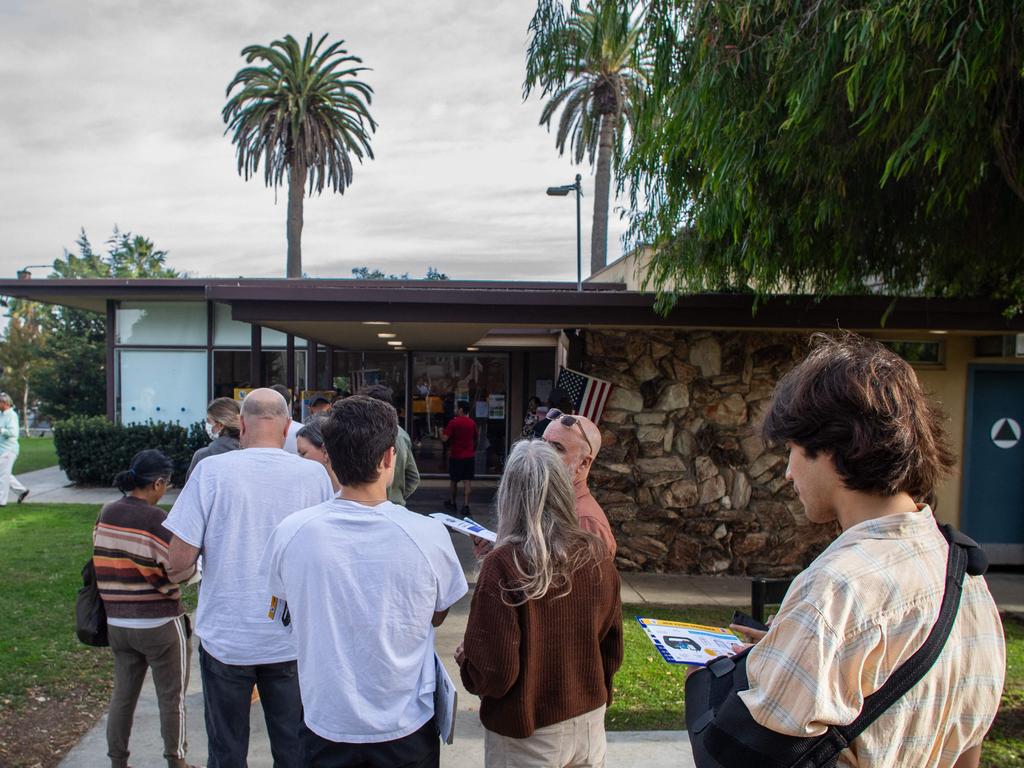‘Red mirage’: New election phenomenon could destroy Donald Trump’s election chances
Early signs in the US election point to a soaring Donald Trump victory over Kamala Harris, but a tricky rule has explained why this could all be fake.

Election experts believe strong early indications that Donald Trump is winning the race for president could be what’s known as a “red mirage”.
The phrase describes the relatively recent phenomenon of a seemingly strong Republican lead when vote counting begins that eventually plunges later on, swamped by a “blue shift”.
Emma Shortis, a senior fellow at RMIT University’s School of Global, Urban and Social Studies, said the results that flow in early on election night can be deceiving.
“There are now many ways to vote in the US – in person on election day, early voting before election day, or by mail-in ballot,” Dr Shortis wrote in analysis for The Conversation.
“And the time it takes to count these different ballots can vary. So, it may appear as if one candidate is winning early in the night – say, when in-person votes are counted – only for their opponent to slowly turn the tide when mail-in ballots are counted.”
Read our full US election coverage here

MORE:Aussie idea could gift Kamala the presidency
Take 2020, when Mr Trump’s early lead was gradually consumed by Joe Biden’s votes.
“Researchers found that counties won by Biden counted more slowly, on average, than those won by Trump – hence the so-called ‘blue shift’.
“This is an entirely normal – and legal – phenomenon. In Nevada, for instance, state law permits mail-in ballots to be counted four days after Election Day, so long as they were postmarked by Election Day.”
Research and trend data indicate Republicans are more likely to vote in-person on the day, and those ballots tend to be counted first, hence the ‘red mirage’.
Democrats are more likely to vote by mail, for example, and those votes are often counted later – sparking the ‘blue shift’.
Also adding to the mirage is the fact that many major cities tend to favour Democratic candidates and counting a huge number of ballots take time.

MORE:Strange truth of Trump’s election home base
“Trump and his surrogates like Steve Bannon have exploited the differing times it takes to count votes to peddle baseless conspiracy theories, undermining Americans’ faith in their own democracy, and to incite unrest.”
On election night in 2020, Mr Trump claimed victory based on the “red mirage” in key states, before counting was completed.
“Trump was able to create what Bannon described as a ‘firestorm’ – one that eventually led to the insurrection of January 6,” Dr Shortis said.

At the weekend, while speaking at a campaign rally in Pennsylvania, Mr Trump said “these elections have to be … decided by 9 o’clock, 10 o’clock, 11 o’clock on Tuesday night”.
Having an outcome on the night, or in the very early hours of the next morning, was the norm for decades as television networks projected winners in each state.
But the tight race in 2020 changed everything, communications expert Professor John Murphy from the University of Illinois explained for The Conversation.
“A raging pandemic, a divided country, a close race, polling failures, false presidential claims of voter fraud and uncertainty made everyone anxious,” Professor Murphy said of media organisations.
“For more than 100 years, media of many kinds tried to be the first to report presidential election results. Although that urge still exists, pundits and analysts are now more concerned with accuracy than speed.”
In almost every election, Republicans appear to take an early lead. It's called the Red Mirage.
— Robert Reich (@RBReich) October 30, 2024
Then that lead gets smaller throughout the night. That's called the Blue Shift.
This is why Trump prematurely declared victory in 2020.
Be prepared for him to do it again. pic.twitter.com/VZ7LzBloER
Election officials in the key swing states of Pennsylvania and Arizona have said counting all postal and early ballots is unlikely to be finished on the night.
“It is a near guarantee that Donald Trump will declare victory the night of November 5 and the margin won’t matter — it won’t matter whether he’s accurate and he actually won, or whether he was defeated soundly,” David Becker, executive director of the Centre for Election Innovation and Research, told the news outlet Axios.
That’s a concern shared by Robert Reich, who was US Secretary of Labor under Bill Clinton and is now a professor at UC Berkley’s Goldman School of Public Policy.
“In 2020, he pretended the blue shift was surprising and suspicious,” Professor Reich said. “He’s going to do it again.”
It’s also possible that a ‘blue mirage’ could emerge in some states, such as Georgia, which counts mail ballots first.
That practice could indicate a strong lead for Kamala Harris that doesn’t reflect the eventual outcome when in-person votes are counted.


The non-profit group Protect Democracy said the term “mirage” was apt because it “describes the way initial reporting of results can be misleading”.
“It’s important for those responsible for reporting on results to make clear that, because early and in-person votes are counted first, they do not necessarily represent the entirety of the electorate,” it said.
“Instead, these ballots might skew toward one party or the other – in the past it has usually been Republicans – and it’s therefore important to exercise patience before drawing too many conclusions from early results.”
But given what happened in 2020, election officials are nervous that delays in finishing the count could be capitalised on to spread misinformation and conspiracy theories.
And if the race is as close as polling has indicated, a long wait is guaranteed. It could be days before America – and the world – knows who will be the next president.
What seems to be the likely outcome today could shift dramatically.
“The overwhelming expectation is that early returns in this year’s key states will look better for Republicans,” Professor Murphy said.
But a blue shift could come and turn the whole contest on its head.






